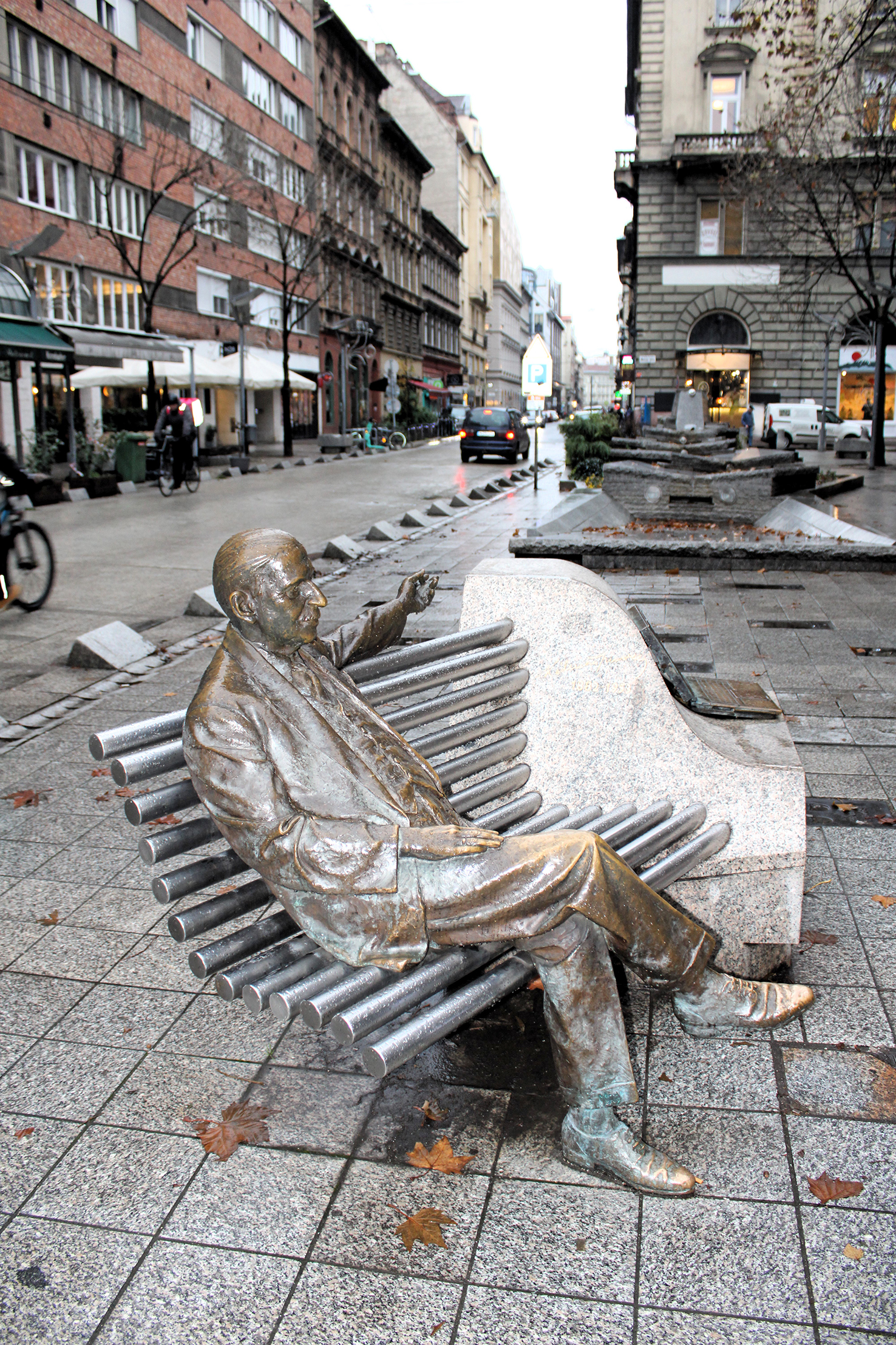A Wander Down Budapest’s Broadway

The statue of composer and conductor Imre Kálmán outside the main entrance to the Budapesti Operettszínház.
Photo by Gabriella Kiss
Somewhat to my embarrassment, I only discovered Nagymező utca was known as Budapest’s Broadway when I interviewed Florian K. Walther, general manager of the new Hard Rock Hotel located midway down the street.
Sitting in the Mai Manó café just down from the junction of Nagymező utca and Andrássy út a week or so later with British journalist and writer Peterjon Cresswell, who has lived in Budapest for 30 years, gazing out at the Budapesti Operettszinhaz opposite, I wondered why I’d never made the connection.
Mai Manó café is a cozy, slightly Moroccan-themed spot in the building that houses the Hungarian House of Photography. This is part museum, part contemporary photography gallery and well worth a visit.
From 1931 to 1944, Mai Manó House was the site of the legendary Arizona nightclub. It was opened by a Hungarian couple returning from America, the artist and composer Sándor Rozsnyai and his wife, the dancer Mária Senger, known as “Miss Arizona.” She got her nickname from the Hungarian writer Dezső Szomory, also known as the Hungarian Proust, who was inspired by her flaming red hair and gentle eyes, which somehow reminded him of the desert.
The Arizona’s heyday was the early period of WWII when Hungary was non-aligned, and the club was frequented by spies, diplomats and members of Budapest’s underworld. It met its end when Rozsynai, who was Jewish, was “disappeared” by the Gestapo in March 1944. After the Germans and the Arrow Cross were finished with the Arizona, the only thing that remained was a gold-framed mirror, still preserved at Mai Manó house.
Today, Nagymező is home to the Microscope Stage, the Radnóti Miklós, Thália, and Tivoli theaters, the Budapesti Operettszínház and the Moulin Rouge nightclub; most are concentrated on either side of Andrássy utca. Directly opposite the Mai Manó café is the Budapest Operetta Theater, built by Viennese architects Fellner and Helmer in 1894. It became home to the operetta in 1923.
Walk of Fame
Outside the main entrance to the theater is a statue of the Hungarian composer and conductor Imre Kálmán, regarded as the father of Hungarian operetta. Over the years, stars of the Hungarian stage have pressed their feet into and signed their names on tiles embedded into the pavement.
If you’d like to take in a performance at the Budapest Broadway, the Operatta, the nearby Franz Liszt Academy of Music and the Hungarian State Opera House a few minutes away on Andrássy utca are your best bet. There are two reasons for this.
The theaters in and around Nagymező only put on Hungarian language plays. Also, as Cresswell explained, it’s extremely difficult to get tickets to the theater in Hungary.
“The theater in Hungary is surprisingly popular and relatively affordable,” Cresswell tells me. “It’s seen as a form of entertainment that one should enjoy and support. A night at the theater is a reason to dress up and go out. This isn’t just true for Budapest. It’s the same in all decent-sized Hungarian cities.”
After we’d pondered the footprints outside the Operetta, Cresswell giving me potted histories of some of their owners, none of whom I’d heard of, we strolled off down Nagymező, heading away from Andrássy.
We stopped outside a bar called Edith at Nagymező 25. Here, Cresswell’s eyes misted over as he recalled the days when this was the site of the legendary Piaf bar.
The Piaf, somewhat a descendant of the Arizona but on a more modest scale, was opened in 1990 by award-winning actor Béla Paudits and his wife, Mária. As Cresswell has written, “With its velvety curtains, faux bordello feel and, most of all, a speakeasy-style window cut into the front door, red-lit with neon outside, the Piaf effortlessly slid into urban myth. If you were in Budapest in the 1990s, you were at the Piaf.”
Theater Crowd
Paudits and his wife hoped to attract the theatrical crowd. No doubt they did. But the Piaf also became known as a haunt for expats searching for Budapest lowlife and its colorful demi-monde. They found it, especially in Piaf’s dark, alcove-pocked and smoky basement. Today, according to Cresswell, the fug of tobacco is recreated in a less life-threatening way by a dry ice machine.
The Piaf eventually closed in 2017. Cresswell suggests this might have been because District VI is “quite well-to-do. They clamped down on the partying, noise and late nights, which they didn’t do in District VII, so that became the party district.”
While it may have led to the closure of the Piaf, this more restrictive attitude has probably preserved the character of District VI. As Cresswell says, “You get more of a sense of turn-of-the-century Budapest.”
Emblematic of this is the splendid Grünberger chandelier shop, sadly closed on the day of our stroll. Today, fourth-generation chandelier master Tamás Gábor Grünberger heads up a family business that has survived global economic collapses, wars, the 1956 Hungarian Uprising and communism and continues to thrive.
The Edith opened in late 2020 and has offered music, movies and alternative events ever since. Sadly, or perhaps fortunately, depending on your point of view, it no longer stays open as late as it did. “You could rock up at 2 a.m. and leave after the trams started running,” Cresswell says wistfully.
As we walked back up towards the Andrássy end of the street, we passed the Hard Rock Hotel. I asked Cresswell why he thought the Hard Rock and the W Hotel, which opened in the former Ballet Institute nearby, have associated themselves with the cultural aspect of Budapest.
“In terms of tourism, Budapest is booming again,” Cresswell said. “I’m not a marketing person, but I guess the marketers at the Hard Rock and the W are looking at what they can offer visitors to change the perception of Budapest as just another European capital. I imagine the way they want to sell the city is as a place of culture, a ‘vibrant’ urban city with a fascinating history. Which is true.”
This article was first published in the Budapest Business Journal print issue of January 12, 2024.
SUPPORT THE BUDAPEST BUSINESS JOURNAL
Producing journalism that is worthy of the name is a costly business. For 27 years, the publishers, editors and reporters of the Budapest Business Journal have striven to bring you business news that works, information that you can trust, that is factual, accurate and presented without fear or favor.
Newspaper organizations across the globe have struggled to find a business model that allows them to continue to excel, without compromising their ability to perform. Most recently, some have experimented with the idea of involving their most important stakeholders, their readers.
We would like to offer that same opportunity to our readers. We would like to invite you to help us deliver the quality business journalism you require. Hit our Support the BBJ button and you can choose the how much and how often you send us your contributions.


.png)







.png)
